What Is Weep Holes | Function of Weep Holes | Types of Weep Holes
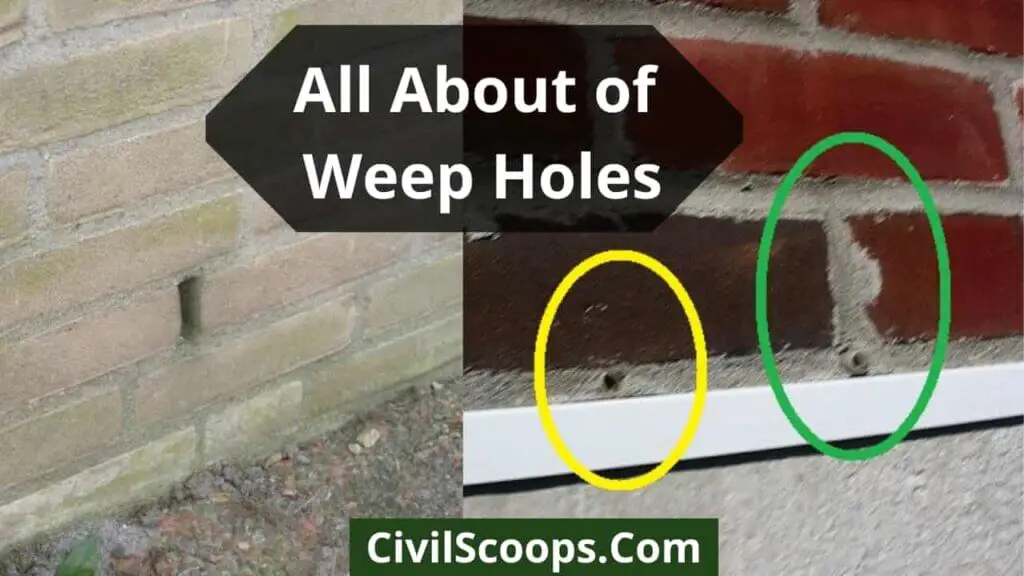
Table of Contents
What Is Weep Holes?
A weep hole, also known as a weep brick, is a small opening that allows water to drain from a structure. The weeps are placed on the bottom of the object to enable drainage; these holes must be large enough to overcome surface pressure. The weeps could also be needed for a retaining wall to allow water to escape from the retained soil, lowering the hydrostatic load on the wall and avoiding moisture damage from freeze/thaw cycles.
In such cases, the weep is made up of small diameter rubber, clay, or metal pipes that reach through the wall to a layer of porous backfill. Weeps are often arranged automatically for water that has penetrated an assembly from under the surface.
To stop interstate condensation, it will be designed with metal windows and glazed curtain walls. Weep Holes are found in earth-retaining buildings such as retaining walls, underpasses, wing walls, and other below-ground drainage structures.
Importance of Weep Holes
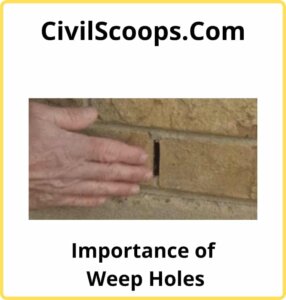
- Internal wall cavity ventilation: Without ventilation, mildew, dry rot, and damp shorten the life of the internal wall studs and other structural materials inside the cavity. The major cause of “Leaky Building Syndrome” is inadequate ventilation.
- Drainage : Water which reaches the cavity by capillary action, condensation, injury, or accidental flooding must find a way out. Flowing water through weep holes in the walls on the dominant side of well-built brick houses during a ‘gully raker’ or monsoonal storm isn’t really uncommon in tropical and sub-tropical Australia..
- Weep holes extend the life of your brick veneer home : They are also helpful to the strength and longevity of your home in the long term. It helps to avoid interior damage to your house by keeping the wall frame dry. Weep holes will assist you in making your home last longer.
Function of Weep Holes

Here, the function of weep holes are as follows.
- In these systems, a weep hole is created to alleviate hydrostatic pressure or water pressure on the walls.
- Reduced water pressure on the walls reduces the structural design demand of the water or earth resisting wall by minimizing thickness and strengthening requirements.
- Weep holes also minimise buoyancy and uplift on surfaces, allowing for the construction of lightweight buildings with no uplift-related stability problems.
- Since there is no chance of water collecting behind the wall if the system is situated near the water desk, a weep hole is not needed.
- That being said, if the structure is located just below water table and there is additional water pressure mostly on framework works that is greater than the saturated pleasures or stress of the earth, a weep hole is needed.
Case 1 : The water table is under the structure, so no weep holes are needed.
- Since the water table is well below the foundation, only ground pressure is taken into account when building it.
Case 2 : The water table should be above the framework and there are no weep holes.
- Once water is combined with dirt, the saturated pleasures as well as earth pressure submerge, which really is less than the saturated pressure, however the water pressure is greater.
- As a result, when planning, this sort of construction, soil, and water pressure should all be taken into account.
Case 3 : The water table is higher than the structure, and weep holes are provided.
- If the water table is above the structure, but weep holes are given.
- The weep hole eliminates the majority of the water pressure, and the water pressure relieves the pores.
- The height of the weep hole is significant because the greater the system is pressurized by water, the higher the height of the weep hole.
- To ensure the correct operation of the weep holes, sand gravel trains are used.
- The variety of holes is determined largely by the structure’s proportions and the height of the water table.
- The weep hole’s height is determined by the maximum possible height of the water’s construction or the actual groundwater table.
Types of Weep Holes
The type of weep holes depends on the nature of the use of the holes:
1. Open Head Joint Weep Holes

Weep holes are created by removing the mortar from the vertical joint between the bricks. The exact space between the open hand joints is performed at 21-inch intervals, and these walls are the same height as the usual joint spacing.
This is the most popular and reliable procedure for removing water from the cavity. This is accomplished by using a weathered plastic structure to avoid rain and penetration into the pores; drip is used on the front lip to aid drainage.
One limitation of this strategy would be that the open head joints produce large gaps that might not be visually pleasing. Any repair staff can even fix such holes unwittingly while noticing they are weep holes. Some materials, such as aluminum vents and plastic grids, can be placed into weep gaps to render holes less visible.
2. Cotton Rope Wicking Weep Holes
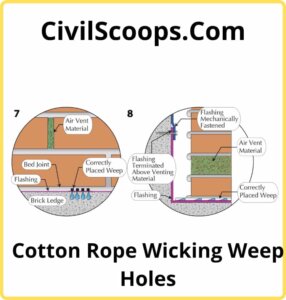
Weeps can be made of cotton wicks. In the joints, a rope up to 12 inches (30 cm) in length is mounted. The rope’s other end is stretched up through the cavity stone.
Cotton can trap moisture inside the wall and wick it to the outside, and cotton rope can wick a slight amount of moisture from the outside to the inside of the wall. The evaporation rate is slower than with weep holes. Furthermore, the cotton could catch fire.
3. Tubes Weep Holes

The tube weep holes are made from hollow plastic or metal pipes that are 16 inches long. The tube is angled at a slight angle to enable water to drain; however, the angle must not be too smooth. If indeed the angle becomes too steep, the gap hole within the wall cavity would be too wide to allow water to escape.
If indeed the angle becomes too shallow, the mortar sometimes used lay the bricks can fall into the cavity and clog the tubes. To save mortar from clogging the channels, a thin coat of gravel is often laid. The plastic tube’s thickness, no matter how thin, can form a small barrier, allowing water to collect within the wall cavity.
Instead of using permanent tubing stock, oiled rods or ropes may be used to shape tubes. The oiled rods or ropes would be inserted in the joints and mortared. The oil stops mortar bonding, and the rods or ropes may be withdrawn after the mortar has hardened, forming a hole similar to that of a tube.
The tube style has the benefit of being less noticeable. However, the small holes can not allow enough air to circulate and vent the moisture.
4. Corrugated Channels
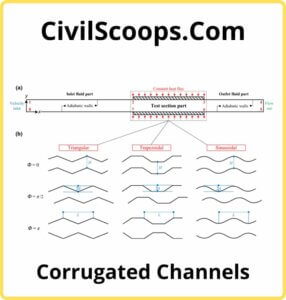
A more recent weep technology employs corrugated plastic to create weep channels/tunnels that form the bottom side of the mortar bed joint. These tunnels quickly conduct water out of the wall through several weep hole openings, ensuring that water exits at the lowest point in the wall.
Corrugated plastic weeps mix into mortar and are less noticeable than rope weeps.
Advantages & Disadvantages of Weep Holes
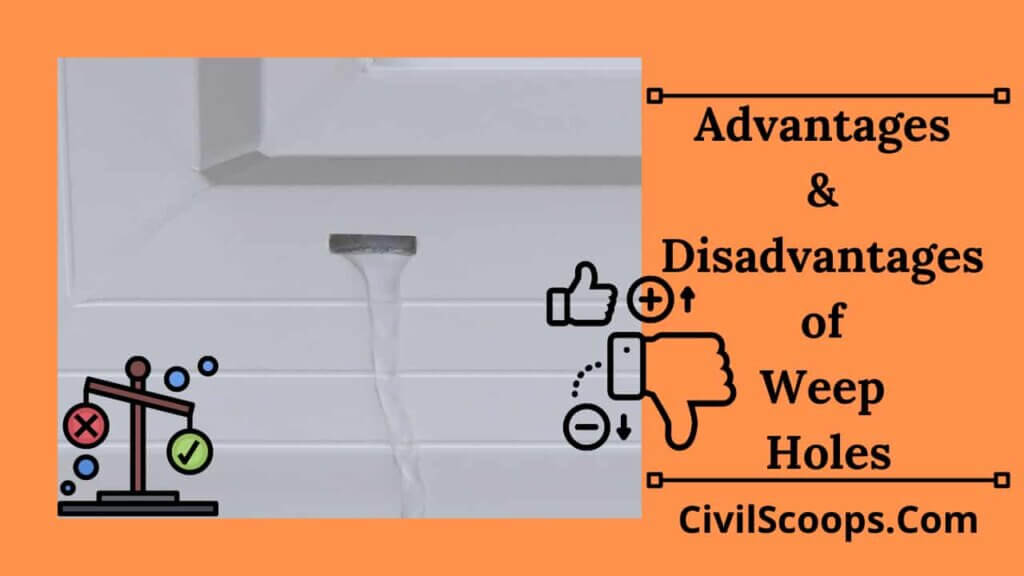
Advantages of Weep Holes
Here, the different pros of weep holes are as follows.
- Weep holes create a gap that allows moisture to drain from the back of the wall through infiltration, capillary action, or leakage.
- It is built in brick masonry to shield the air behind the wall from mildew, dry rot, and damp, which reduces the building’s life and efficiency.
- They are mostly located inside the exterior masonry of cavity walls, but they can also be found above the home windows and doors.
- They are provided at regular intervals to allow moisture to escape, with a suggested distance of 450 mm between row holes.
- From an engineering standpoint, weep holes reduce hydrostatic pressure or water pressure on the walls.
- By reducing the thickness and strengthening needed, this decreases the structural construction requirement for water and earth strain.
- The weep hole further reduces buoyancy and uplift on the frame, allowing for the construction of a lighter structure with no uplift-related stabilization problems.
Disadvantages
Here, the different cons of weep holes are as follows.
- Blockage of Weep Holes Due to Trash Mortar: When weep holes are constructed in brick masonry, mortars wedge between successive courses of bricks and fall into the weep cavity. This will help to avoid weep holes by scratching the mortar.
- Pest Infiltration Through Weep Holes: Pests such as rats and insects may gain entry via weep holes. The interior of the building can be accessed through ventilator fans and holes for plumbing and electrical purposes underneath the lights.
- Baffled vents can be installed to solve this issue.
- Obstruction in Airflow: To address the above issues of insect invasion and garbage mortar, as well as to make the weep hole more appealing, the weep hole does not have the requisite flow of air to adequately ventilate the internal brick wall.
[su_box title=”FAQ” style=”default” box_color=”#333333″ title_color=”#FFFFFF” radius=”3″ class=”” id=””]
Weep Holes
A weep hole is a passage for water to escape a building envelope. Weep holes serve an important purpose of a home; they allow the home to “breathe” as some say. Since there are many chances for water to enter the home, weep holes allow for water exit.
Vinyl Window Weep Holes
Although not all windows have weep holes you may see them on vinyl or metal window frames. Weep holes aren’t just there for looks, they are designed to drain water from your windows.
Water Coming Through Brick Weep Hole
The excess mortar overflows into the airspace, where it hardens. When water enters the brick cavity, it can pool on the hardened mortar, and subsequently leak into the house. Also, excess mortar at the bottom of the wall can block the weep holes, preventing water in the brick cavity from draining to the exterior.
Weep Drains
Definition. Weep holes are a vital part of your shower drain assembly. Typically, there are three such holes in the upper portion of the drain assembly, spaced evenly around the drain. The weep holes are small holes that connect to the main drain, allowing water that enters them to feed into the drainpipe.
Drilling Holes in Basement Floor for Drainage
A drill and a masonry bit can be used to drill the holes. I’d recommend a 5/8 to ¾ inch hole in each cavity. You don’t need to drill all the blocks initially. Simply concentrate on the area where water is seeping out.
Weep Holes in Basement Floor
Weep holes are drilled in the concrete blocks at the lowest level. Once the block has been drilled, water exits at the holes and flows directly into the drainage system. Weep holes have the added benefit of helping alleviate pressure on your foundation walls.
Weep Holes in Concrete Foundation
What are weep holes? Weep holes are tiny openings that allow water to drain from within your foundation walls. They’re usually drilled into the base of foundation walls to allow moisture to escape. Whenever water gets into the foundation, it will drip down the back of the wall and pass through the weep holes.
Seawall Weep Holes
Seawall weep holes are created just above the waterline to release the water that accumulates behind the structure. By allowing the passage of excess water, the holes prevent hydrostatic pressure from building up on the landside of the seawall.
Weep Holes in Foundation Wall
What is a weep hole? A weep hole is a small hole that’s drilled on the base of your foundation wall to provide aeration and an escape route for water. The weep hole also does the following: improves drainage: rainwater or moisture that gets into the concrete block or brick cavity needs to escape.
Basement Weep Holes
What is a weep hole? A weep hole is a small hole that’s drilled on the base of your foundation wall to provide aeration and an escape route for water. The weep hole also does the following: improves drainage: rainwater or moisture that gets into the concrete block or brick cavity needs to escape.
[/su_box]
[su_note note_color=”#F2F2F2 ” text_color=”#333333″ radius=”3″ class=”” id=””]
Like this post? Share it with your friends!
Suggested Read –
- What Is Lintel? | Function of Lintel | Types of Lintel
- How a Building Is Constructed | Components of Building
- Building Layout | How to Building Layout | Construction Layout Techniques
- What Is Gable Roof | History of Gable Roofing | Gable Roof Design | Parts of Gable Roof | Types of Gable Roofs | How Long Can the Roof Last? | Gable Roof Advantages and Disadvantages | Cost of Gable Roof Construction
- What Is Bituminous Road? | Bituminous Road Construction | Bituminous Road Layers | Bituminous Macadam | Bituminous Road Construction Process | Advantages of Bitumen Road | Disadvantages of Bitumen Road | Application Road
- What Is Super Elevation? | Superelevation Definition | Purpose of Providing Superelevation in Roads | Calculation of Superelevation in Roads | Minimum and Maximum Superelevation in Roads | Method of Providing Superelevation to the Roads
[/su_note]
Originally posted 2024-04-05 05:13:59.
